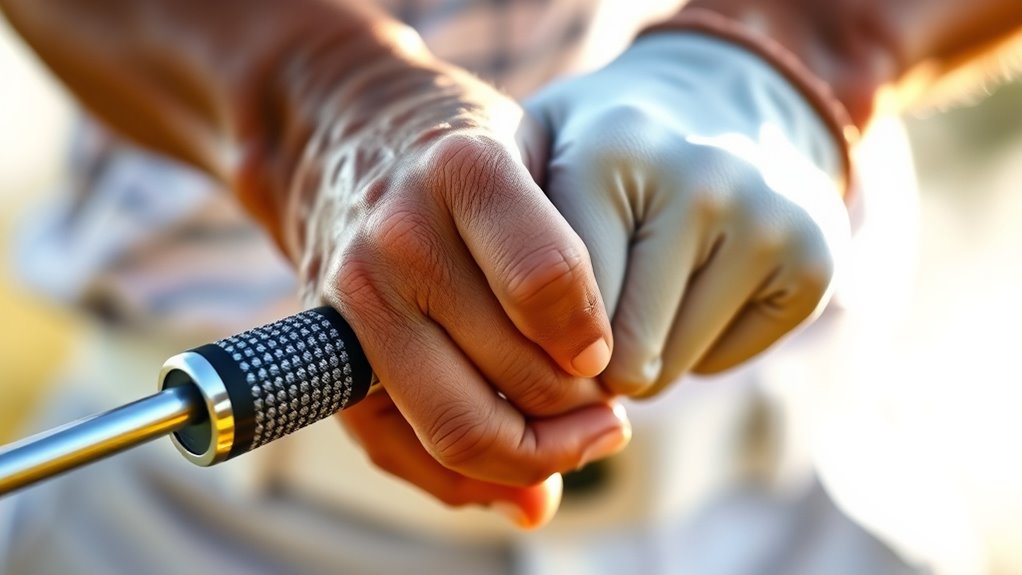To improve your swing, start with a proper stance by standing shoulder-width with balanced weight and a comfortable grip. Keep your eyes fixed on the ball to track its movement and time your swing perfectly. Maintain a smooth, controlled rhythm, using your hands and wrists effectively to generate power without stiffness. Follow through confidently, extending your arms and keeping your swing level. Mastering these basics boosts your consistency, and if you continue exploring, you’ll discover even more tips to refine your swing.
Key Takeaways
- Adopt a shoulder-width stance with balanced weight distribution for stability and smooth swings.
- Keep your eyes focused on the ball to improve timing and contact accuracy.
- Maintain a controlled, smooth swing with consistent rhythm to develop muscle memory.
- Use your hands and wrists effectively, keeping wrists loose for quick, powerful movements.
- Follow through confidently with full extension to maximize bat speed and control.
Focus on a Proper Stance

Have you ever wondered why your swing feels off? It’s often because of your stance. A proper stance starts with your foot positioning—stand shoulder-width apart, weight evenly distributed. This gives you stability and balance, making it easier to swing smoothly. Next, focus on your grip technique; hold the bat comfortably but firmly, with your hands aligned. A good grip prevents the bat from twisting and helps control your swing. Keep your hands close to your body, and don’t grip too tightly. Your stance should feel natural and balanced, allowing you to move freely during your swing. When your foot positioning and grip technique are correct, you’ll notice better control and more consistent contact with the ball.
Keep Your Eyes on the Ball
Why is it so important to keep your eyes on the ball? Because tracking the pitch helps you judge its speed and trajectory, giving you better control. When you focus on the ball, you improve your timing, making it easier to swing at the right moment. Missing this focus can lead to missed hits or poor contact. Use this table to understand key aspects:
| Focus Area | Why It Matters | Tips for Improvement |
|---|---|---|
| Tracking the pitch | Helps anticipate the ball’s path | Watch the pitcher’s hand closely |
| Eye coordination | Ensures accurate contact | Practice focusing on moving objects |
| Timing your swing | Increases the chance of a solid hit | Swing when the ball reaches ideal point |
| Depth perception | Aids in judging distance | Keep your eyes steady on the ball |
| Consistency | Builds better hitting habits | Practice keeping your eyes on the ball throughout your swing |
Good visual awareness supports all these aspects by helping you maintain focus on the ball’s movement.
Maintain a Smooth and Controlled Swing

Focusing on keeping your eyes on the ball sets the foundation for a solid swing, but controlling your movement through the entire swing is equally important. To maintain a smooth and controlled swing, focus on good bat control. Avoid rushing; instead, work on a consistent swing rhythm that feels natural and fluid. A controlled swing helps you stay balanced and ensures you make solid contact. Keep your movements deliberate, with a steady pace from the load to the follow-through. This consistency builds muscle memory and improves your timing. Remember, a smooth swing isn’t about power alone—it’s about precision and control. By maintaining a steady rhythm and focusing on bat control, you’ll develop more reliable and effective swings at the plate. Additionally, understanding the importance of cookie categories can help you better manage your preferences and enhance your overall browsing experience.
Use Your Hands and Wrists Effectively

Using your hands and wrists effectively is essential for generating quick, controlled bat speed and making solid contact. Start with proper grip techniques—hold the bat comfortably but firmly, ensuring your hands work together smoothly. Wrist flexibility is key; keep your wrists loose to allow for a quick, whipping motion through the ball. As you swing, focus on flicking your wrists at the point of contact to maximize power and control. Avoid overly stiff wrists, which can slow your swing and reduce accuracy. Instead, maintain a relaxed grip and flexible wrists to respond quickly to different pitches. Practicing wrist exercises can improve your flexibility over time, helping you develop a more fluid, confident swing that consistently makes solid contact. Additionally, understanding swing mechanics can help you refine your technique for better results.
Follow Through With Confidence

A confident follow-through is essential for maximizing your swing’s power and consistency. When you finish strong, you maintain bat speed and keep your swing path on the right track. A smooth, committed follow-through helps transfer energy efficiently, leading to better contact. Focus on extending your arms toward the target and finishing high. To visualize proper follow-through, consider this table:
| Stage | Key Focus | Result |
|---|---|---|
| Initiation | Keep your eyes on the ball | Better contact accuracy |
| Swing Path | Maintain a level, direct path | Consistent bat speed |
| Contact Point | Hit through the ball | Increased power |
| Follow Through | Extend fully towards the pitcher | Maximize bat speed |
| Finish | Hold your finish position | Confidence and control |
This approach ensures your swing feels natural and effective, boosting your overall hitting ability. Additionally, practicing with AI-enhanced training tools can help you analyze and improve your follow-through mechanics more effectively.
Frequently Asked Questions
How Can I Improve My Timing at the Plate?
To improve your timing at the plate, focus on developing better bat control and rhythm. Practice rhythm drills regularly to sync your swing with the pitcher’s delivery. Concentrate on maintaining a steady tempo and staying relaxed, which helps you anticipate the pitch better. By refining your timing through consistent drills, you’ll react faster and make more solid contact, boosting your overall hitting performance.
What Should I Do if My Swing Feels Inconsistent?
When your swing feels like a weather vane in a storm, it’s time to steady your approach. Focus on mental focus to stay calm and consistent. Make grip adjustments to feel more control and connection. Practice slow, deliberate swings to find your rhythm. By sharpening your mental focus and refining your grip, you’ll bring stability to your swing, turning the chaos into a smooth, confident motion.
How Do I Adjust My Stance for Different Pitches?
To adjust your stance for different pitches, focus on your bat positioning and weight distribution. When a pitch is high, slightly elevate your stance and shift your weight back to stay on top of the ball. For low pitches, lower your stance and lean forward a bit. Keep your bat positioned comfortably and maintain balanced weight distribution so you can react quickly and make solid contact regardless of the pitch location.
What’s the Best Way to Develop Power Without Sacrificing Control?
Think of your swing like a lightning bolt—powerful yet controlled. To develop power without losing control, focus on increasing your bat speed by practicing explosive swings, but keep your grip tension light to avoid stiffening your muscles. I once saw a player gain 10 mph on their bat speed by relaxing their grip, which allowed for smoother, more powerful swings. Balance strength and control, and you’ll hit with both power and precision.
How Can I Prevent Injuries While Practicing My Swing?
To prevent injuries while practicing your swing, always prioritize safety. Wear proper protective gear like helmets and gloves to shield yourself from potential impacts. Incorporate warm-up routines, including stretching and light swings, to prepare your muscles and joints. Stay mindful of your technique, avoid overexertion, and listen to your body. Regularly taking these precautions helps you enjoy practice sessions while minimizing injury risks.
Conclusion
Mastering these tips will set you on the path to becoming a better hitter. Focus on your stance, keep your eye on the ball, swing smoothly, and use your hands wisely. Remember, confidence is key—don’t be afraid to follow through like a true hero from a bygone era. With practice and determination, you’ll be swinging like a pro before you know it. So step up, swing hard, and let the game bring out the champion in you.









